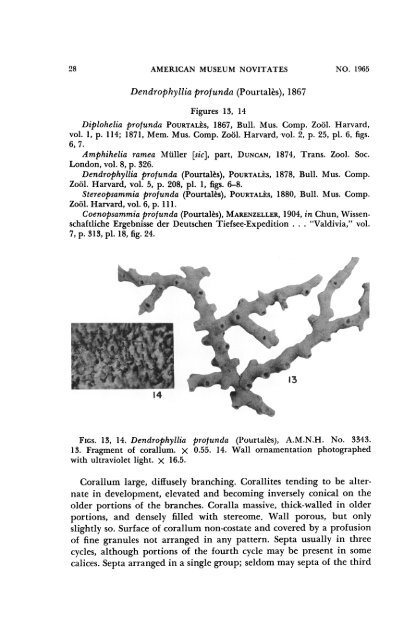MXieuicanJAuscum - American Museum of Natural History
MXieuicanJAuscum - American Museum of Natural History
MXieuicanJAuscum - American Museum of Natural History
Create successful ePaper yourself
Turn your PDF publications into a flip-book with our unique Google optimized e-Paper software.
9218 AMERICAN MUSEUM NOVITATES<br />
NO. 1965<br />
Dendrophyllia pr<strong>of</strong>unda (Pourtales), 1867<br />
Figures 13, 14<br />
Diplohelia pr<strong>of</strong>unda POURTALES, 1867, Bull. Mus. Comp. Zool. Harvard,<br />
vol. 1, p. 114; 1871, Mem. Mus. Comp. Zool. Harvard, vol. 2, p. 25, pl. 6, figs.<br />
6,7.<br />
Amphihelia ramea Muller [sic], part, DUNCAN, 1874, Trans. Zool. Soc.<br />
London, vol. 8, p. 326.<br />
Dendrophyllia pr<strong>of</strong>unda (Pourtalks), POURTALES, 1878, Bull. Mus. Comp.<br />
Zool. Harvard, vol. 5, p. 208, pl. 1, figs. 6-8.<br />
Stereopsammia pr<strong>of</strong>unda (Pourta1Ms), POURTALES, 1880, Bull. Mus. Comp.<br />
Zool. Harvard, vol. 6, p. 111.<br />
Coenopsammia pr<strong>of</strong>unda (PourtalMs), MARENZELLER, 1904, in Chun, Wissenschaftliche<br />
Ergebnisse der Deutschen Tiefsee-Expedition . . . "Valdivia," vol.<br />
7, p. 313, pl. 18, fig. 24.<br />
14<br />
FIGS. 13, 14. Dendrophyllia protunda (IPourta6s), A.M.N.H. No. 3343.<br />
13. Fragment <strong>of</strong> corallum. X 0.55. 14. Wall ornamentation photographed<br />
with ultraviolet light. x 16.5.<br />
Corallum large, diffusely branching. Corallites tending to be alternate<br />
in development, elevated and becoming inversely conical on the<br />
older portions <strong>of</strong> the branches. Coralla massive, thick-walled in older<br />
portions, and densely filled with stereome. Wall porous, but only<br />
slightly so. Surface <strong>of</strong> corallum non-costate and covered by a pr<strong>of</strong>usion<br />
<strong>of</strong> fine granules not arranged in any pattern. Septa usually in three<br />
cycles, although portions <strong>of</strong> the fourth cycle may be present in some<br />
calices. Septa arranged in a single group; seldom may septa <strong>of</strong> the third
















